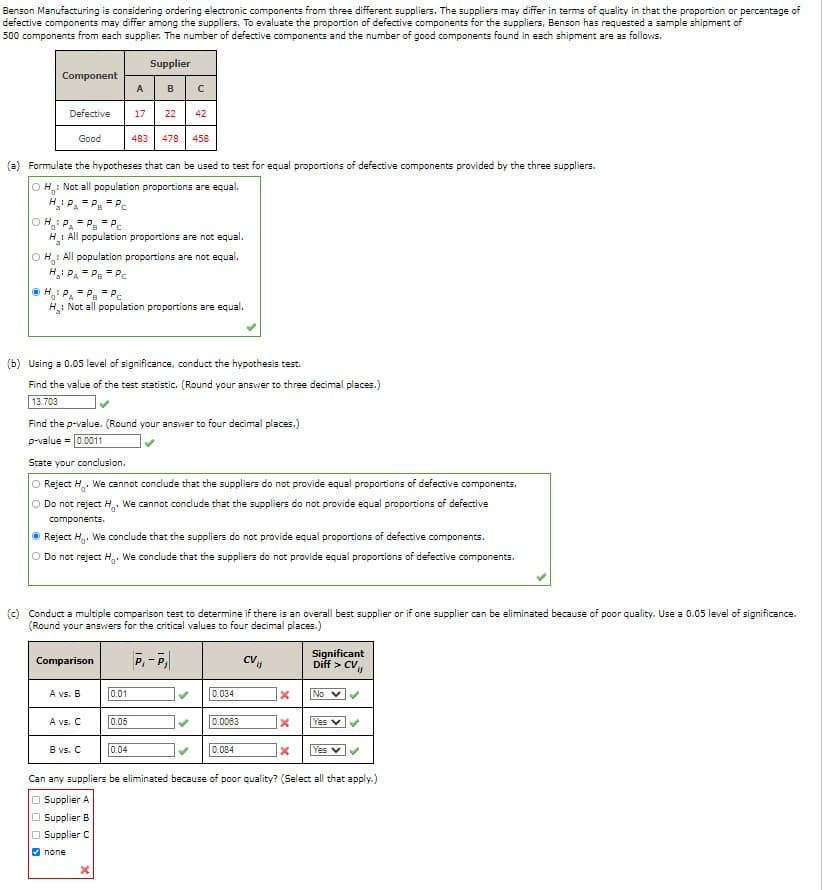son Manufacturing is considering ordering electronic components from three dif ective components may differ among the suppliers. To evaluate the proportion of components from each supplier. The number of defective components and the Supplier Component A B C Defective 17 22 42 Good 483 478 458 Formulate the hypotheses that can be used to test for equal proportions of de OH: Not all population proportions are equal.
son Manufacturing is considering ordering electronic components from three dif ective components may differ among the suppliers. To evaluate the proportion of components from each supplier. The number of defective components and the Supplier Component A B C Defective 17 22 42 Good 483 478 458 Formulate the hypotheses that can be used to test for equal proportions of de OH: Not all population proportions are equal.
Glencoe Algebra 1, Student Edition, 9780079039897, 0079039898, 2018
18th Edition
ISBN:9780079039897
Author:Carter
Publisher:Carter
Chapter10: Statistics
Section10.6: Summarizing Categorical Data
Problem 13CYU
Related questions
Question

Transcribed Image Text:Benson Manufacturing is considering ordering electronic components from three different suppliers. The suppliers may differ in terms of quality in that the proportion or percentage of
defective components may differ among the suppliers. To evaluate the proportion of defective components for the suppliers, Benson has requested a sample shipment of
500 components from each supplier. The number of defective components and the number of good components found in each shipment are as follows.
Component
Supplier
A B C
Defective
17 22 42
Good
483 478 458
(a) Formulate the hypotheses that can be used to test for equal proportions of defective components provided by the three suppliers.
OH: Not all population proportions are equal.
H₂: PA=PB = Pc
OH PA=P = Pc
H: All population proportions are not equal.
OH: All population proportions are not equal.
H₂: PA = PB = Pc
ⒸHPA P₁ Pc
Not all population proportions are equal.
(b) Using a 0.05 level of significance, conduct the hypothesis test.
Find the value of the test statistic. (Round your answer to three decimal places.)
13.703
✔
Find the p-value. (Round your answer to four decimal places.)
p-value = 0.0011
✓
State your conclusion.
O Reject H. We cannot conclude that the suppliers do not provide equal proportions of defective components.
O Do not reject H. We cannot conclude that the suppliers do not provide equal proportions of defective
components.
Reject H. We conclude that the suppliers do not provide equal proportions of defective components.
O Do not reject H. We conclude that the suppliers do not provide equal proportions of defective components.
(c) Conduct a multiple comparison test to determine if there is an overall best supplier or if one supplier can be eliminated because of poor quality. Use a 0.05 level of significance.
(Round your answers for the critical values to four decimal places.)
Comparison
Significant
Diff > CV
A vs. B
0.01
0.034
X
No
A vs. C
0.05
0.0063
X
Yes ✓
B vs. C
0.04
0.084
x
Yes
Can any suppliers be eliminated because of poor quality? (Select all that apply.)
Supplier A
Supplier B
Supplier C
X
✔none
Expert Solution
This question has been solved!
Explore an expertly crafted, step-by-step solution for a thorough understanding of key concepts.
Step by step
Solved in 3 steps with 2 images

Recommended textbooks for you

Glencoe Algebra 1, Student Edition, 9780079039897…
Algebra
ISBN:
9780079039897
Author:
Carter
Publisher:
McGraw Hill

Holt Mcdougal Larson Pre-algebra: Student Edition…
Algebra
ISBN:
9780547587776
Author:
HOLT MCDOUGAL
Publisher:
HOLT MCDOUGAL


Glencoe Algebra 1, Student Edition, 9780079039897…
Algebra
ISBN:
9780079039897
Author:
Carter
Publisher:
McGraw Hill

Holt Mcdougal Larson Pre-algebra: Student Edition…
Algebra
ISBN:
9780547587776
Author:
HOLT MCDOUGAL
Publisher:
HOLT MCDOUGAL
